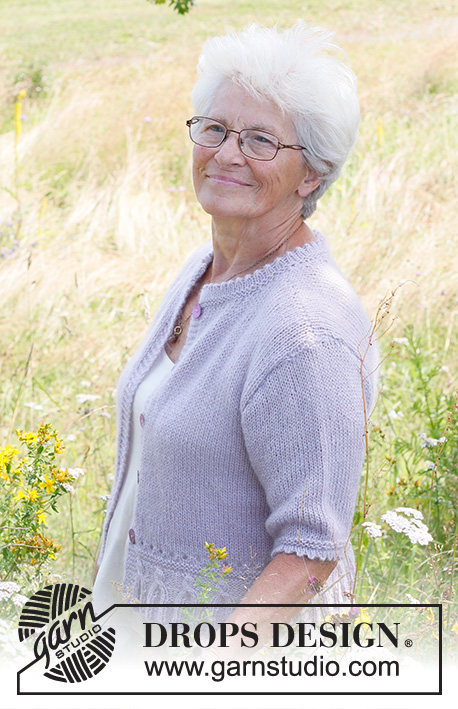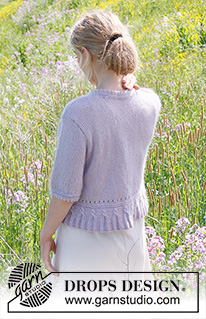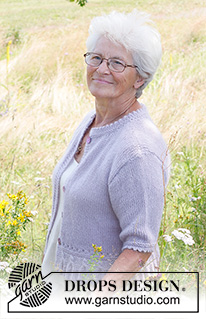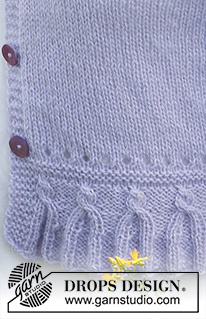Provence Purple Cardigan |
|||||||||||||||||||||||||||||||
 |
 |
||||||||||||||||||||||||||||||
Knitted jacket in DROPS Alpaca and DROPS Kid-Silk. The piece is worked bottom up, with short sleeves and double neck. Sizes S - XXXL.
DROPS 232-52 |
|||||||||||||||||||||||||||||||
|
------------------------------------------------------- EXPLANATIONS FOR THE PATTERN: ------------------------------------------------------- RIDGE/GARTER STITCH (worked back and forth): Knit all rows. 1 ridge = knit 2 rows. PATTERN: See diagrams A.1 to A.4. The diagrams show all rows in the pattern from the right side. BUTTONHOLES: Work the buttonholes on the right band. 1 BUTTONHOLE = knit together the 3rd and 4th stitch from the edge and make 1 yarn over. On the next row knit the yarn over to leave a hole. Work the buttonholes when the piece measures: S: 10, 17, 25, 33 and 41 cm = 4", 6¾", 9¾", 13" and 16⅛" M: 10, 18, 26, 34 and 43 cm = 4", 7", 10¼", 13⅜" and 17" L: 10, 18, 26, 35 and 44 cm = 4", 7", 10¼", 13¾" and 17¼" XL: 10, 19, 28, 37 and 46 cm = 4", 7½", 11", 14½" and 18" XXL: 10, 19, 28, 37 and 47 cm = 4", 7½", 11", 14½" and 18½" XXXL: 10, 19, 29, 39 and 49 cm = 4", 7½", 11⅜", 15¼" and 19¼" DECREASE TIP (armholes and neck): Decrease inside 2 stitches: At the end of each row from the right side: Work until there are 4 stitches left, knit 2 together, 1 stockinette stitch and 1 garter stitch. At the beginning of each row from the right side: 1 garter stitch, 1 stockinette stitch, slip 1 stitch as if to knit, knit 1 and pass the slipped stitch over the knitted stitch, work to the end of the row as before. INCREASE TIP (sleeves): Work until there is 1 stitch left before the marker, 1 yarn over, knit 2 (marker sits between these 2 stitches), 1 yarn over. On the next round knit the yarn overs twisted to avoid holes. Then work the new stitches in stockinette stitch. ------------------------------------------------------- START THE PIECE HERE: ------------------------------------------------------- JACKET – SHORT OVERVIEW OF THE PIECE: The piece is worked back and forth with circular needle, bottom up as far as the armholes, then divided and the front and back pieces finished separately. The sleeves are worked bottom up in the round, with double pointed needles/short circular needle as far as the sleeve cap and finished back and forth. JACKET: Cast on 299-327-355-383-425-453 stitches with circular needle size 4 MM = US 6 and 1 strand DROPS Alpaca and 1 strand DROPS Kid-Silk. Purl 1 row from the wrong side, then work as follows from the right side: 5 band stitches in GARTER STITCH – read description above, * knit 2, purl 5 *, work from *-* until there are 7 stitches left, knit 2 and 5 band stitches in garter stitch. Continue this rib for 3 cm = 1⅛". Decrease 1 stitch in each purled section by purling the first 2 stitches together (from the right side). Repeat this decrease when the rib measures 4 cm = 1½", but now purling together the last 2 stitches in each purled section = 217-237-257-277-307-327 stitches. Work as follows from the right side: 5 band stitches in garter stitch, A.1A, 20-22-24-26-29-31 times, A.1B and 5 band stitches in garter stitch. When A.1 is finished in height there are 175-191-207-223-247-263 stitches and the piece measures approx. 9 cm = 3½". Purl 1 row from the wrong side where you decrease 17-17-21-21-21-17 stitches evenly spaced (do not decrease over the bands) = 158-174-186-202-226-246 stitches. REMEMBER THE BUTTONHOLES – see description above. Work A.2 over all stitches(bands knitted) – on the 7 th row in A.2, work as follows from right side: 5 band stitches in garter stich, knit 1-1-1-0-0-1, repeat A.2 until it remains 5-6-6-5-5-6 stitches, knit 0-1-1-0-0-1 stitches and 5 band stitches in garter stitch. Change to circular needle size 5 MM = US 8 and continue with stockinette stitch and 5 band stitches in garter stitch on each side. REMEMBER THE KNITTING GAUGE. When the piece measures 29-30-31-32-33-34 cm = 11⅜"-11¾"-12¼"-12½"-13"-13⅜", bind off for the armholes on the next row as follows: Work 39-43-46-50-56-61 stitches, bind off 6 stitches, work 68-76-82-90-102-112 stitches, bind off 6 stitches, work the last 39-43-46-50-56-61 stitches. Each section is finished separately. Place the first and last 39-43-46-50-56-61 stitches on a thread and work the back piece over the remaining 68-76-82-90-102-112 stitches. BACK PIECE: = 68-76-82-90-102-112 stitches. Continue with stockinette stitch, AT THE SAME TIME decrease for the armholes on each side – read DECREASE TIP: 1 stitch 2-4-5-8-12-15 times = 64-68-72-74-78-82 stitches. When the piece measures 45-47-49-51-53-55 cm = 17¾"-18½"-19¼"-20"-21"-21⅝", bind off the middle 24-26-28-30-32-34 stitches for the neck and finish each shoulder separately. Then bind off 1 stitch on the next row from the neck = 19-20-21-21-22-23 stitches. Continue with stockinette stitch until the piece measures 48-50-52-54-56-58 cm = 19"-19¾"-20½"-21¼"-22"-22¾" (armhole = 19-20-21-22-23-24 cm = 7½"-8"-8¼"-8¾"-9"-9½"), bind off. Work the other shoulder in the same way. RIGHT FRONT PIECE: Place the first 39-43-46-50-56-61 stitches back on circular needle size 5 MM = US 8. Continue with stockinette stitch and 5 band stitches in garter stitch mid-front and decrease for the armhole in the side – remember DECREASE TIP: 1 stitch 2-4-5-8-12-15 times = 37-39-41-42-44-46 stitches. When the piece measures 42-44-45-47-48-50 cm = 16½"-17¼"-17¾"-18½"-19"-19¾", place the 14-15-16-17-18-19 stitches mid-front on a thread for the neck. Then decrease 1 stitch 4 times by the neck every 2nd row – remember DECREASE TIP = 19-20-21-21-22-23 stitches on the shoulder. Continue with stockinette stitch until the piece measures 48-50-52-54-56-58 cm = 19"-19¾"-20½"-21¼"-22"-22¾" (armhole = 19-20-21-22-23-24 cm = 7½"-8"-8¼"-8¾"-9"-9½"). Bind off. LEFT FRONT PIECE: Place the last 39-43-46-50-56-61 stitches back on circular needle size 5 MM = US 8. Continue with stockinette stitch and 5 band stitches in garter stitch mid-front and decrease for the armhole in the side – remember DECREASE TIP: 1 stitch 2-4-5-8-12-15 times = 37-39-41-42-44-46 stitches. When the piece measures 42-44-45-47-48-50 cm = 16½"-17¼"-17¾"-18½"-19"-19¾", place the 14-15-16-17-18-19 stitches mid-front on a thread for the neck. Then decrease 1 stitch 4 times by the neck, every 2nd row – remember DECREASE TIP = 19-20-21-21-22-23 stitches on the shoulder. Continue with stockinette stitch until the piece measures 48-50-52-54-56-58 cm = 19"-19¾"-20½"-21¼"-22"-22¾" (armhole = 19-20-21-22-23-24 cm = 7½"-8"-8¼"-8¾"-9"-9½"). Bind off. SLEEVES: Cast on 44-46-48-50-52-54 stitches with double pointed needles size 4 MM = US 6 and 1 strand DROPS Alpaca and 1 strand DROPS Kid-Silk (= 2 strands). Work A.3 in the round. When A.3 is finished in height continue with stockinette stitch, AT THE SAME TIME on the first round increase 8 stitches evenly spaced = 52-54-56-58-60-62 stitches. Change to double pointed needles size 5 MM = US 8. Insert 1 marker at the beginning of the round = mid-under sleeve. When the sleeve measures 6 cm = 2⅜" (measured from the folding edge), increase 1 stitch on each side of the marker – read INCREASE TIP. Increase like this every 10-6-4-3-1½-1 cm = 4"-2⅜"-1½"-1⅛"-½"-⅜" a total of 2-3-4-6-7-9 times = 56-60-64-70-74-80 stitches. When the piece measures 21-20-20-20-19-17 cm = 8¼"-8"-8"-8"-7½"-6¾", bind off 3 stitches on each side of the marker (6 stitches bind off), then finish the sleeve-cap back and forth. Bind off at the beginning of each row as follows: 2 stitches 3-3-3-3-3-4 times and 1 stitch 1-2-2-2-3-3 times on each side. Then bind off 2 stitches on each side until the sleeve measures 28 cm = 11" in all sizes, 3 stitches 1 time on each side and bind off the remaining stitches. The sleeve measures 29 cm = 11⅜" in all sizes. Work the other sleeve in the same way. ASSEMBLY: Sew the shoulder seams. Sew in the sleeves. Sew the buttons onto the left band. NECK: Start from the right side and knit up 76 to 106 stitches (including the stitches on the threads and divisible by 2) using 1 strand DROPS Alpaca and 1 strand DROPS Kid-Silk and circular needle size 4 MM = US 6. Knit 1 row from the wrong side, knit 1 row from the right side and knit 1 row from the wrong side. Then work as follows: ROW 1 (right side): 1 edge stitch in garter stitch, knit until there is 1 stitch left, 1 edge stitch in garter stitch. ROW 2 (wrong side): 1 edge stitch in garter stitch, A.4 until there is 1 stitch left, 1 edge stitch in garter stitch. Work A.4 1 time in height. Then purl 1 row from the wrong side with 1 edge stitch in garter stitch on each side. Bind off a little loosely. Fold the neck double to the wrong side, at the folding edge in A.4 and sew down to the top ridge. |
|||||||||||||||||||||||||||||||
Diagram explanations |
|||||||||||||||||||||||||||||||
|
|||||||||||||||||||||||||||||||

|
|||||||||||||||||||||||||||||||

|
|||||||||||||||||||||||||||||||
|
Have you made this or any other of our designs? Tag your pictures in social media with #dropsdesign so we can see them! Do you need help with this pattern?You'll find tutorial videos, a Comments/Questions area and more by visiting the pattern on garnstudio.com. © 1982-2024 DROPS Design A/S. We reserve all rights. This document, including all its sub-sections, has copyrights. Read more about what you can do with our patterns at the bottom of each pattern on our site. |
|||||||||||||||||||||||||||||||



















































































Comments / Questions (10)
Guten Tag, ich möchte diese zauberhafte Jacke bzw. den Pullover mit einer anderen Wolle stricken, für die ich Nadeln in der Stärke drei benötige - Baunwollgarn von Drops. Wie kann ich das Ganze umrechnen, denn Teile mit kurzen Ärmeln kann ich im Winter nicht tragen. Und diese Wolle ist mir im Sommer viel zu warm. Ich lebe im Süden Europas ..... Hoffentlich können Si Emir helfen. (Maschenprobe bei Nadelstärke 3 sind 24 Maschen in der Breite.)
04.01.2023 - 11:10DROPS Design answered:
Liebe Ramona, leider können wir nicht jede Anleitung nach jeder Anfrage bzw jeder Maschenprobe umrechnen, aber hier finden Sie alle Jacken mit 25-23 Maschen für 10 cm - davon können Sie sich sicher inspirieren. Viel Spaß beim stricken!
04.01.2023 - 14:03Ne tenez pas compte de ma question, je viens de comprendre mon erreur. Désolé
26.09.2022 - 16:01Je me demande s'il n y a pas une erreur dans les explications, car sur la partie diminution emmanchure on tricote 39 mailles , on rabat 6m, on tricote 68 mailles on rabat 6 mailles et on tricote les 39 mailles finales, le problème pour les explications suivantes on se retrouve avec le même nombres de mailles 39 m 68 m 39 mailles où sont passé les 12 mailles diminuées ?
26.09.2022 - 15:51In the diagram instructions there is a * after the last instruction then a left arrow folding line. I think this instruction should not be in this pattern.
06.06.2022 - 15:39DROPS Design answered:
Dear Sandra, when you work A.3 on the sleeve edge, you will work this row together with the stitches on cast on edge, see diagram key to the 8th symbol. Happy knitting!
07.06.2022 - 10:33Après avoir effectuer A.1A etA.1B, il devrait rester 191m en gr. M Les diminutions se font au 11e rang pour les 2 diagrammes, ma question les 2 m qui étaient en attente sur l’aiguille à torsade doit-on aussi les tricoter ENSEMBLES torse? Sinon où se fait l’autre diminution ? Merci de votre aide
06.06.2022 - 04:17DROPS Design answered:
Bonjour Carole, tout à fait, vous diminuez 2 mailles dans chacune des torsades; glissez 2 mailles sur l'aiguille à torsades devant l'ouvrage, tricotez 2 mailles ensemble torse à l'endroit (= on diminue 1 m), reprenez les 2 mailles sur l'aiguille à torsades et tricotez-les ensemble torse à l'endroit (mention ajoutée de suite, merci pour votre retour). Bon tricot!
07.06.2022 - 09:48I believe the seventh symbol on your list is incorrect. It is worked over five stitches but only accounts for three stitches
03.04.2022 - 17:06DROPS Design answered:
Dear Mrs Hullett, thanks for your feedback, diagram text has been fixed. Happy knitting!
04.04.2022 - 10:54Hurra! I viser præcis de billeder, der skal til, for at man får det bedste indtryk af det strikkede. Man ser det forfra, fra siden og fra ryggen. Masser det på en ung slank model og en ældre, som er mere fyldig. Der er nærbillede af mønstret. Det er super. Kan ikke gøres bedre. Gør gerne det noget mere. Det er meget bedre end alle de strikketøjer, hvor I viser flere næsten identiske billeder som regel skråt forfra.
30.03.2022 - 15:34Wunderschön! Die Jacke wird auf alle Fälle genadelt!
20.02.2022 - 10:39Lilac lady
18.01.2022 - 19:36Sans chichis
17.01.2022 - 14:14